You have a target keyword. You want to have your website appear in the search results for that keyword.
How do you do that? How do you actually rank for a keyword?
Follow this guide to find out how.
Just because a keyword exists doesn’t mean it’s the right one to target.
Sometimes a keyword is merely a subtopic under a broader, main topic. Or it might be an alternative way of phrasing that’s not the most popular one.
Google knows this, and thus ranks almost the same pages for all of those keywords. For example, our keyword research guide ranks for 2,100 keywords:
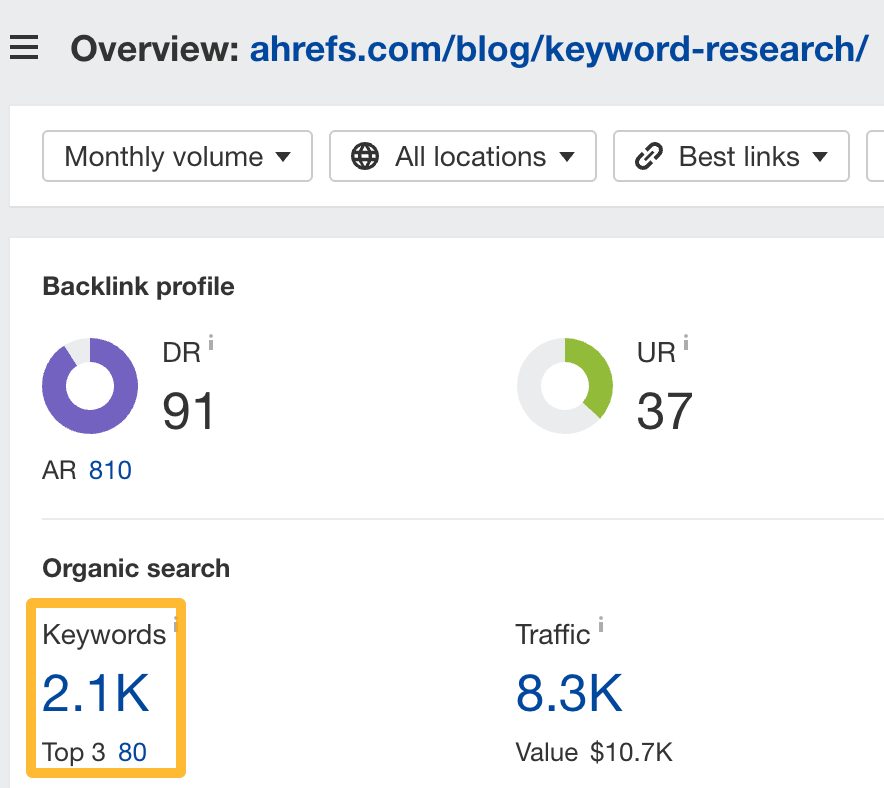
Most of them are simply variations of the main topic of “keyword research”:

You also want to make sure you’re not targeting a keyword that nobody is searching for. Otherwise, you’ll waste all your time and effort.
How can you find out if you’re targeting the right keyword? Easy: go to Keywords Explorer and enter your target keyword. For example, let’s say I enter “how to create content”. Here’s what I see:
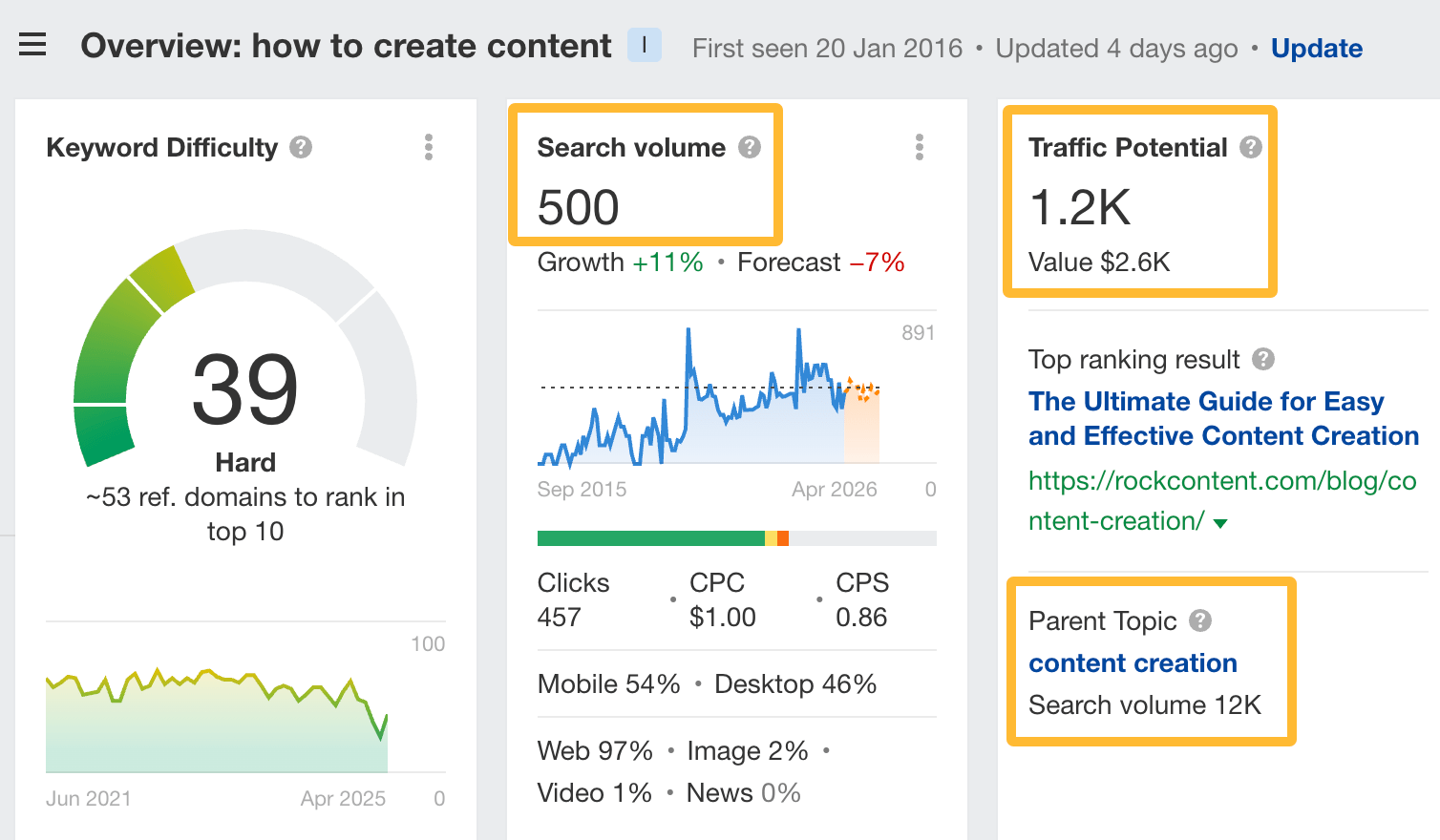
So, search volume tells me that the keyword “how to create content” is searched for 500 times a month. However, it’s likely a subtopic and not a main one because its overall Traffic Potential is much higher at 1,200.
Sidenote.
Traffic Potential is the total amount of organic traffic that the #1 ranking page for your target keyword gets from all the keywords it ranks for.
Parent Topic tells me that the likely main topic is “content creation”. So, this topic is worth targeting because it has a high traffic potential but we should be targeting “content creation” instead (and not “how to create content”.)
Ranking #1 means nothing if it doesn’t help your bottom line. You don’t just want search traffic; you want search traffic that converts to customers.
Before you chase a keyword, assign it a Business Potential score.

For example, the topic “keyword research” scores a “3”, because it’s nearly impossible to do good keyword research without a tool. For “content creation”, it’s likely a “2” because you can make content without a tool, but you can do it even better with one.
You want to prioritize keywords that score at least a 2 and above.
Sure that your target keyword is the keyword you want? Awesome. Now you need to know what Google wants to rank.
Google ranks pages that best satisfy what people are looking for. So, if your content doesn’t match what users expect to see, you won’t rank.
How do you know what Google is looking for? Easy: look at the SERPs to figure out search intent.
For example, if we look at the top-ranking pages for “content creation”, we see that they’re mostly beginner’s guides on content creation:
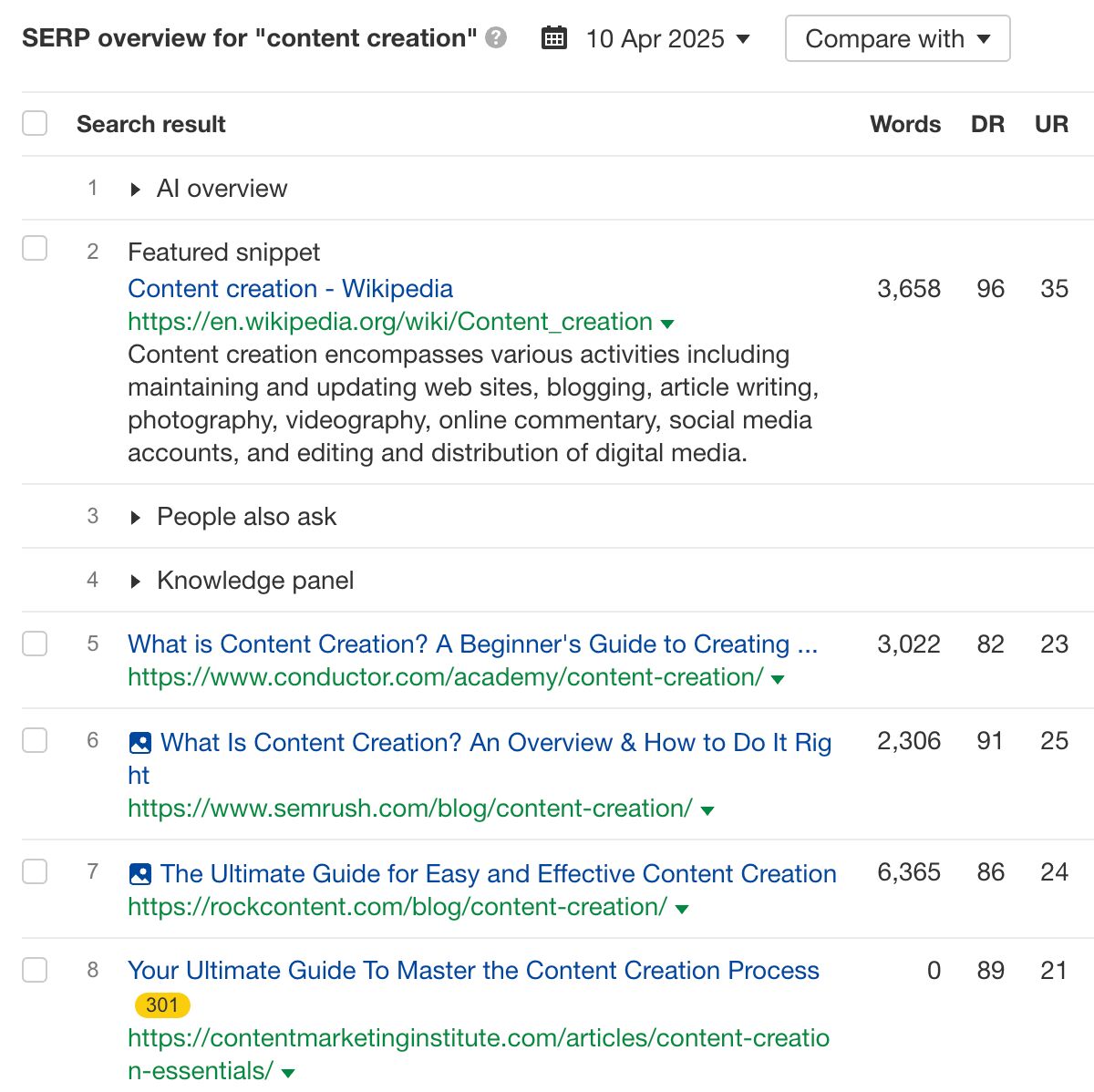
An even faster way to figure out search intent is to simply click the Identify intents button in Keywords Explorer:

So, if we want to rank for this keyword, we’ll likely have to make a beginner’s guide that covers what content creation is, how to create, and more.
Good search content is exhaustive: it covers all the steps of the process, lists all the resources the reader needs, and answers all the questions that need answering. It delivers on its promises and leaves no important gaps in its information.
Even Google’s Helpful Content guidelines ask: “Does the content provide a substantial, complete, or comprehensive description of the topic?”
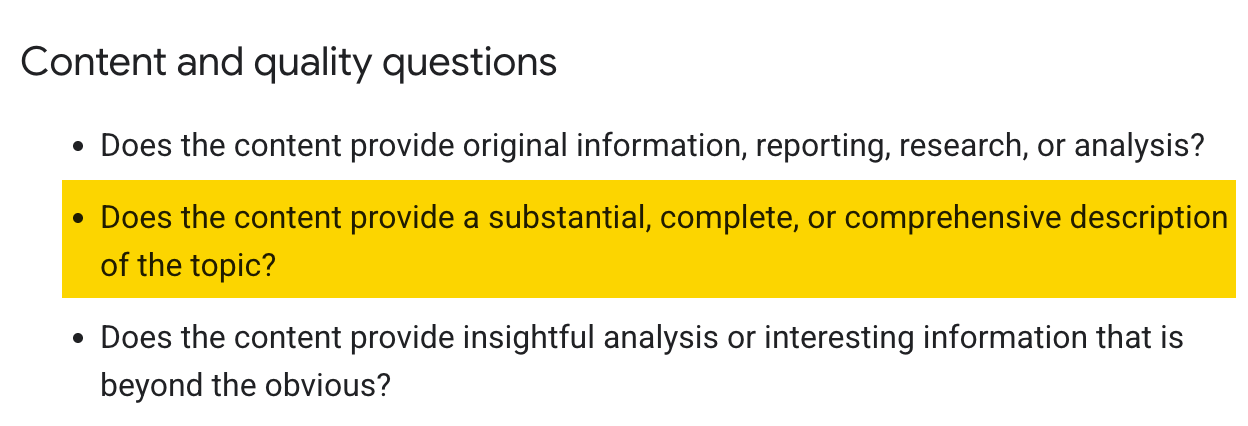
To find out what subtopics you should cover, enter your keyword into AI Content Helper and it’ll suggest subtopics to cover. For example, here’s what it suggests for “content creation”:
- What is content creation
- AI in content creation
- Steps involved in creating content (e.g., ideation, planning, creation, etc.)
- Content performance analytics
- Role of SEO in content creation
- Content strategy
- Types of content
- Content creation tools
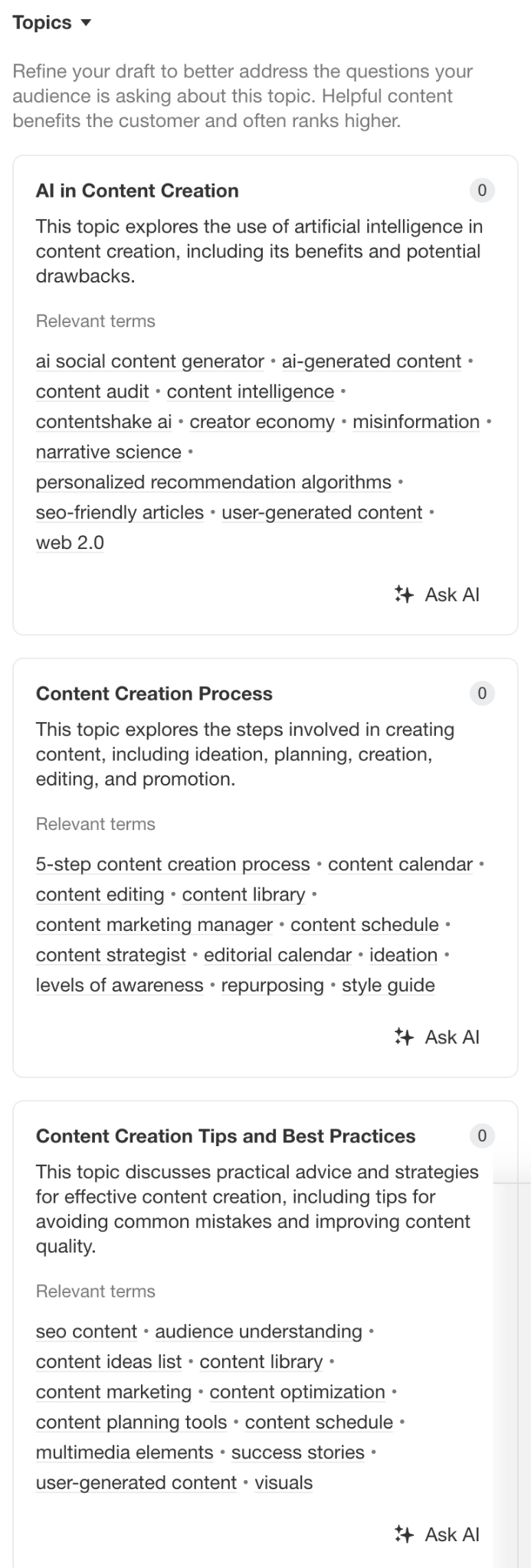
All important subtopics if you want to create a comprehensive beginner’s guide.
Let’s be honest: the Internet doesn’t need another generic article about your topic. If someone searches for your keyword, there are likely hundreds of thousands, even millions, of results.
Why should anyone care about yours?
In the content game, “good enough” is no longer, well, good enough. With Google’s AI Overviews stealing clicks and people turning to AI search engines, generic content is becoming increasingly invisible.
Even if you manage to create the most comprehensive guide ever, you’ll still fail if your content looks and feels like everything else out there.
Your content needs a unique angle that makes people think, “Wow, I’ve never seen it presented this way before!”
How do you find these unique angles? There are three approaches:
- Experimentation: Be the original source and create your own data that others will want to cite. Conduct a mini-experiment, run a poll, or collect data from your user base.
- Experience: Anyone can write theory. Few can write from hard-won experience. Share your firsthand insights from doing or trying something.
- Effort: Most content creators are lazy. Use that to your advantage. What could you add to your content that would make competitors look at it and think, “That would be too much work”?
For example, when Ryan Law, our Director of Content Marketing wanted to write about the best AI image generators, he didn’t just list them out. He actually went and tested all of them:

Your outline’s done, your subtopics are set. It’s time to get the actual words out on the page. Set a time and handcraft it or use your best prompts on ChatGPT—it’s your choice. Just make sure you:
- Write introductions that grab readers by the collar: Either keep your introductions short and snappy or snap your readers out of their daze with a bold claim, surprising statistic, or counterintuitive truth.
- Write like a human talking to another human: You can use AI but don’t sound like one. Be conversational. Share opinions. Use “I” and “you.”
- Break up text: Use images, charts, blockquotes, bullets, numbered lists, and occasional one-sentence paragraphs to keep the reader’s eyes moving.
- Make your advice actionable: Don’t just say “conduct keyword research”. Show exactly how with screenshots, templates, and specific steps. Remove all guesswork.
Think of on-page SEO as speaking Google’s love language. Your content might be amazing to human readers, but it also needs to be communicated in a way Google understands.
The checklist is really simple:
- Include the target keyword in the title, URL, H1, and the intro paragraph.
- Write an engaging meta description.
- Link to other useful pages on your website.
- Add alt text to all your images.
Links are a Google ranking factor. So, if you want to rank high on Google, it’s likely you’ll need links to your content. Especially if you’re gunning for a highly competitive keyword.
To acquire backlinks, you need to give people a reason to link to you. Every link building strategy is a variation of a reason. For example, guest blogging works as a link building strategy because you’re giving the other party a free piece of content in exchange for linking back.
Likewise for podcast link building: you offer free insights as a guest and the podcast host links back to you.
That’s why I say you need a unique angle for your content. If you have data, stories, or design that no one else has, it makes acquiring links an easier sell to other websites.
Link building is a massive topic on its own, so I recommend reading our guide to link building to learn how it works.
If you Google your keyword today, you’ll likely see a massive AI Overview:
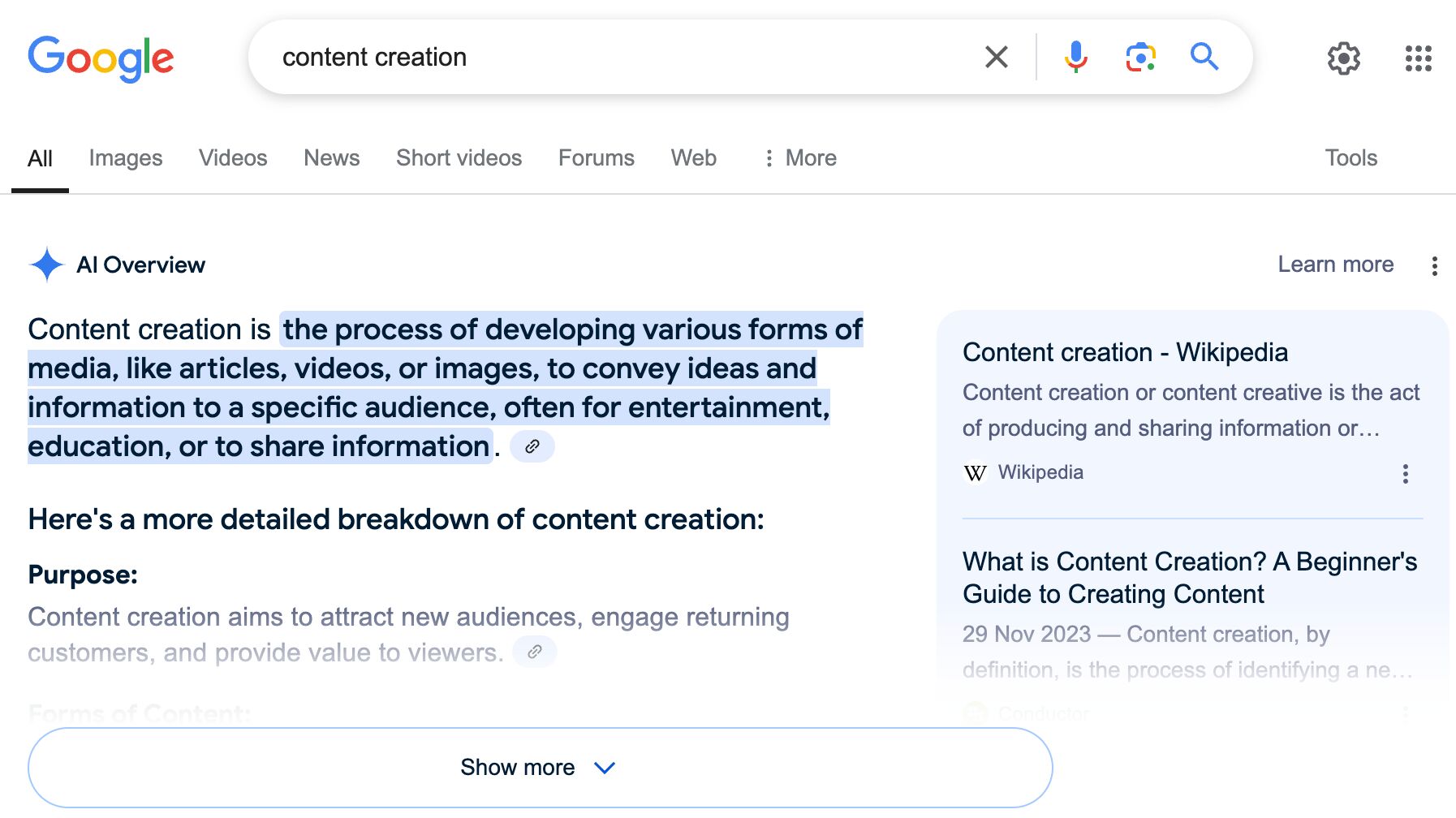
You’ll likely be thinking two questions:
- How do I get in there?
- Is there still a point in ranking on Google? Shouldn’t I do LLM optimization instead?
Firstly, don’t panic. Take a deep breath.
Google’s AI Overviews still need source material to generate their summaries. And that source material or citation, at least at the moment, still comes from search.
So, whether you want to call it LLMO, GEO, or the name of the week, it’s no different from SEO. At least for the time being. I highly recommend reading Ryan’s post on why this is so.
Tl;dr: The strategy remains fundamentally the same: Create exceptional, comprehensive, uniquely valuable content that serves user needs better than anything else out there.
Final thoughts
Even perfect content won’t rank if search engines can’t properly access and understand your site. Technical SEO issues can silently undermine your ranking efforts.
I recommend signing up for our free Ahrefs Webmaster Tools and running a crawl of your website. Catching and fixing glitches early can save you from mysteriously missing out on search traffic.
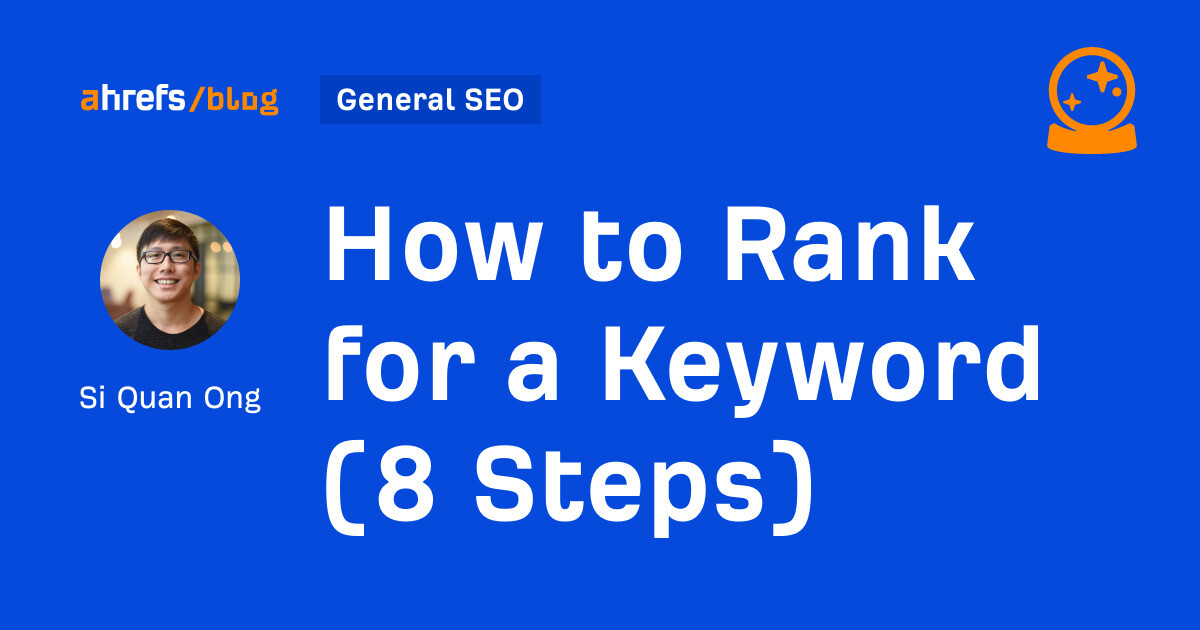
Leave a Reply